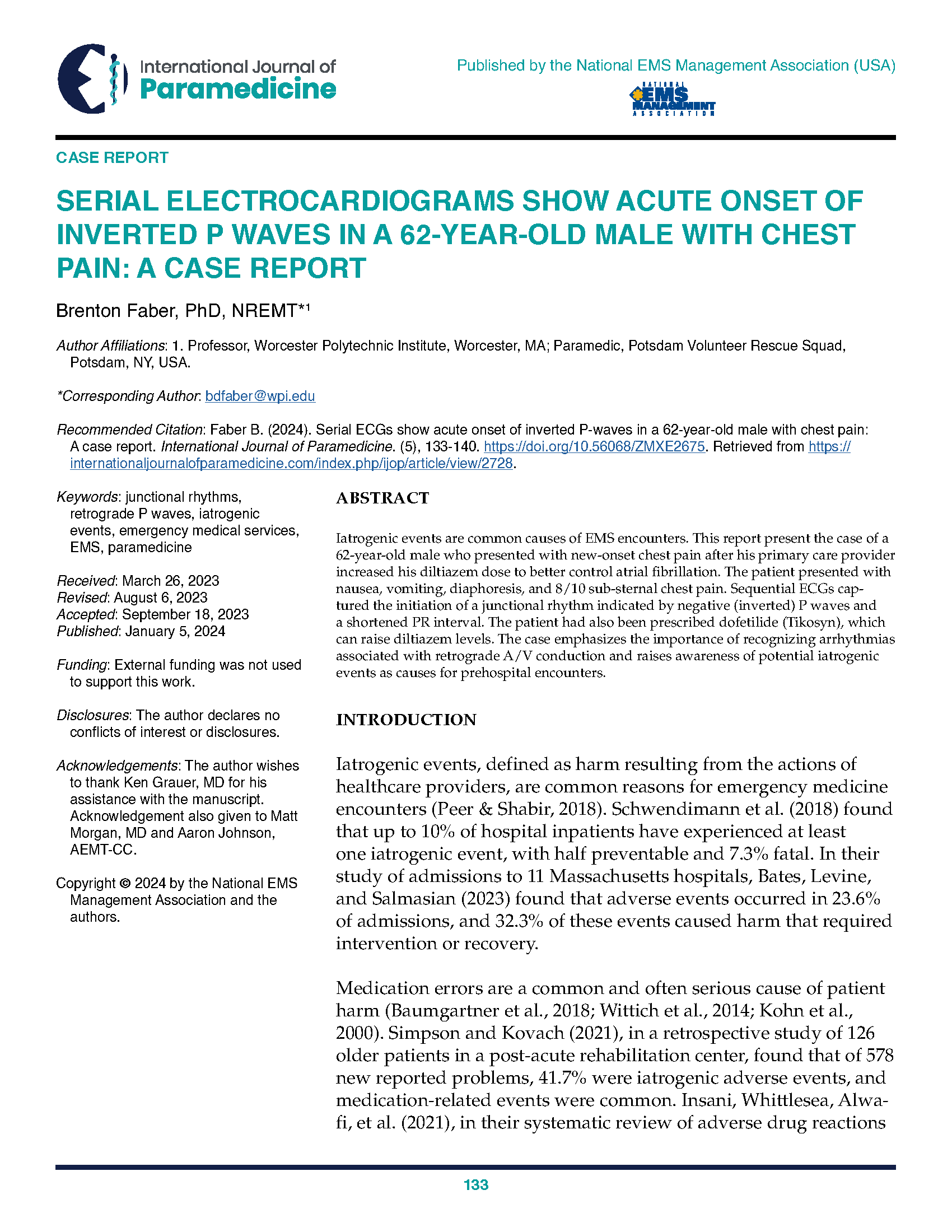Serial Electrocardiograms Show Acute Onset of Inverted P Waves in a 62-Year-Old-Male with Chest Pain A Case Report
Main Article Content
Abstract
Iatrogenic events are common causes of EMS encounters. This report present the case of a 62-year-old male who presented with new-onset chest pain after his primary care provider increased his diltiazem dose to better control atrial fibrillation. The patient presented with nausea, vomiting, diaphoresis, and 8/10 sub-sternal chest pain. Sequential ECGs captured the initiation of a junctional rhythm indicated by negative (inverted) P waves and a shortened PR interval. The patient had also been prescribed dofetilide (Tikosyn), which can raise diltiazem levels. The case emphasizes the importance of recognizing arrhythmias associated with retrograde A/V conduction and raises awareness of potential iatrogenic events as causes for pre-hospital encounters.
Article Details

This work is licensed under a Creative Commons Attribution-ShareAlike 4.0 International License.
Publishing in IJOP allows authors to keep their copyright while giving IJOP unrestricted copyright permissions. Articles published in IJOP use Creative Common Attribution 4.0 International (CC BY-ND 4.0) licensing. This license requires that re-users give credit to the creator. It allows re-users to copy and distribute the material in any medium or format in unadapted form only, even for commercial purposes. Additional terms apply and can be accessed here.
Publishing in IJOP also allows authors to have contracts for non-exclusive distribution of the Journal's published version of the article, such as posting to an institutional repository or publication in a book, on the condition that the original publication in the original layout format in IJOP is retained and acknowledged.
We permit and encourage authors to post the articles they published in IJOP on their affiliated websites. This helps share the information, encourages citation in other works, and promotes scholarly discourse in the spirit of open access.
References
Adams, M. G., & Pelter, M. M. (2004). Retrograde atrial conduction. American Journal of Critical Care, 13, 251-252. https://doi.org/10.4037/ajcc2004.13.3.251.
Bates, D. W., Levine, D. M., Salmasian H., et al. (2023). The safety of inpatient health care. New England Journal of Medicine, 388(2): 142-153. https://doi.org/10.1056/NEJMsa2206117.
Baumgartner, A., Kunkes, T., Clark, C., Brady, L. A., Monte, S. V., Singh, R., Whaler, R. J., & Chen H-Y., W. (2020). Opportunities and recommendations for improving medication safety: Understanding the medication management system in primary care through an abstraction hierarchy. JMIR Human Factors, 7(3). https://doi.org/10.2196/18103.
Billette, J. & Tadros, R. (2019). An integrated overview of AV node physiology. Pacing and Clinical Electrophysiology, 42(7), 805-820. https://doi.org/10.1111/pace.13734.
Burns, E., & Buttner, R. (2021). Junctional escape rhythm. Life in the Fastlane. Accessed from: https://litfl.com/junctional-escape-rhythm-ecg-library/.
Buttner, R., & Burns, E. (2022). Accelerated junctional rhythm (AJR). Life in the Fastlane. 1/5. Accessed from: https://litfl.com/accelerated-junctional-rhythm-ajr/.
Chakraborty, R., K. & Hamilton, R., J. (2023). Calcium channel blocker toxicity. StatPearls. Treasure Island, FL: StatPearls Publishing. https://www.ncbi.nlm.nih.gov/books/NBK537147/
Levine, M. (2018). Cardiac Medications. In Cydulka, R. K., Fitch, M. T., Joing S. A., et al. (Eds.). Tintinalli’s Emergency Medicine Manual (8th Ed.). New York: McGraw Hill/American College of Emergency Physicians.
Epocrates. Dofetilide Interaction Check. Accessed from: https://online.epocrates.com/results?query=dofetilide. Last Accessed 6/4/2023.
Fogoros, R. (2022). Importance of the atrioventricular (AV) Node. Verywell Health, 8/29. Accessed from: https://www.verywellhealth.com/atrioventricular-node-av-1746280.
Grauer, K. (2019). Comment. Dr. Smith’s ECG Blog. 2/28. Accessed from: https://hqmeded-ecg.blogspot.com/2019/01/what-is-going-on-here-computer-called.html.
Hafeez, Y., & Grossman, S. A. (2022). Junctional rhythm. StatPearls [Internet]. Treasure Island FL. Accessed from: https://www.ncbi.nlm.nih.gov/books/NBK507715/.
Ibrahim, M. A., Kerndt, C. C., & Tivakaran, V.S. (2023). Dofetilide. StatPearls. Treasure Island FL: StatPearls Publishing. Accessed from: https://www.ncbi.nlm.nih.gov/books/NBK459154/
Insani, W., Whittlesea, C., Alwafi H., et al. (2021) Prevalence of adverse drug reactions in the primary care setting: A systematic review and meta-analysis. PLoS One, 16(5): e0252161. https://doi.org/10.1371/journal.pone.0252161
Jafri, S. H., Xu, J., Warsi, I., & Cerecedo-Lopez, C. (2021). Diltiazem versus metoprolol for the management of atrial fibrillation: A systematic review and meta-analysis. American Journal of Emergency Medicine, 48 (October), 323-327. https://doi.org/10.1016/j.ajem.2021.06.053.
Kohn, L. T., Corrigan, J., Donaldson, M. S., Eds (2000). Institute of Medicine Committee on Quality of Health Care in America. To Err is Human: Building a Safer Health System. Washington, DC: National Academy Press. https://doi.org/10.17226/9728.
Morrow, D. A., & de Lemos, J. A. (2019). Stable ischemic heart disease. In: Zipes, D. Libby, P. Bonow, R. O., Mann, D. L., & Tomaselli, G. F. (Eds.), Braunwald’s Heart Disease: A Textbook of Cardiovascular Medicine 11th ed, pp. 1209-1270. Philadelphia PA: Elsevier.
Peer, R. F., & Shabir, N. (2018). Iatrogenesis: A review on nature, extent, and distribution of healthcare hazards. Journal of Family Medicine and Primary Care, 7(2), 309-314. https://doi.org/10.4103/jfmpc.jfmpc_329_17.
Schwendimann, R., Blatter, C., Dhaini, S., Simon, M., & Ausserhofer, D. (2018). The occurrence, types, consequences and preventability of in-hospital adverse events – a scoping review. BMC Health Services Research, 18(1), 521. https://doi.org/10.1186/s12913-018-3335-z.
Sheikh, A. & Bates, D. (2014). Iatrogenic harm in primary care. Harvard Health Policy Review 14(1), 4-8. Accessed from: https://issuu.com/harvardhealthpolicyreview/docs/2014_fall_iatrogenesis.
Simpson, M. & Kovach, C. R. (2021). New problems and iatrogenic events among older adults in the first 30 days of post-acute rehabilitation. Research in Gerontological Nursing, 14(6): 293-304. https://doi.org/10.3928/19404921-20210924-02.
Wittich, C. M., Burkle, C. M., & Lanier, W. L. (2014). Medication errors: An overview for clinicians. Mayo Clinic Proceedings, 89:1116-25. https://doi.org/10.1016/j.mayocp.2014.05.007.
Wong, J., Lee, S-Y., Sarkar, U. & Sharma A. E. (2022). Medication adverse events in the ambulatory setting: A mixed-methods analysis. American Journal of Health- System System Pharmacy, 79(24): 2230-2243. https://doi.org/10.1093/ajhp/zxac253.

